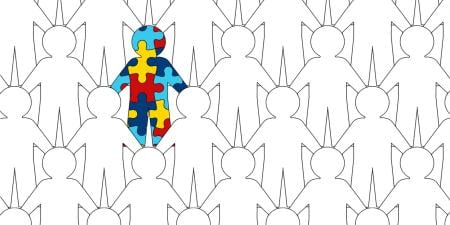Case
Dr. Peterson smiled at Elizabeth, a 15-month-old who was in his office for her well-child check. He made small talk with Elizabeth’s mother for a few minutes while Elizabeth played with a doll from the exam room’s toy chest.
“Do you have any concerns today?” he asked the mother.
Elizabeth’s mother smiled. “Not really,” she said. “She’s been a little slow to talk—her brothers were both talking much more at this age—but I think she’s catching up.”
Dr. Peterson noticed that Elizabeth was flapping her hands slightly. “Does she do that often?” he asked the mother.
“Oh, once in a while.”
He continued to observe Elizabeth play as he asked her mother a series of questions. Elizabeth continued to flap her hands throughout the interview. To Dr. Peterson, it looked like “stimming,” or self-stimulation, behavior that is frequently associated with autism. Elizabeth had poor eye contact, although she did respond to her name and come to her mother’s side when called. She also rocked back and forth on her knees, singing to herself lightly. The hand-flapping, rocking behavior, and poor eye contact gave Dr. Peterson reason to consider autism.
He hesitated. According to Elizabeth’s mother, Elizabeth had met all of her developmental milestones, although recently it seemed that her speech development was not on track. There were plenty of signs that she could be developing normally: she played with the doll attentively and demonstrated affection toward it, she responded to her name, and was well-behaved. Her mother—who had two older children—hadn’t noticed anything out of the ordinary.
Dr. Peterson considered his course of action. He knew that Elizabeth would undergo routine screening for autism at her 18-month visit and didn’t feel that he saw anything severe enough to warrant an extensive evaluation at the moment. However, he wondered if Elizabeth’s mother had a right to know that he was concerned. He was apprehensive that conveying his concern to the mother involved a certain degree of unnecessary risk: it would mostly likely cause increased anxiety for the family and possibly spur Elizabeth’s parents to perceive normal behavior as pathology. But did he have an ethical obligation to share his concerns with her mother?
Commentary
In this vignette it is evident that Dr. Peterson is an excellent and caring clinician. He understands his ethical obligations to act in the best interests of his patients with possible neurodevelopmental disorders. Dr. Peterson wonders about the option to initiate an early intervention program for Elizabeth now, before moving on to see his next awaiting patient. It would not be controversial to help arrange for an early intervention program that provides a free neurodevelopmental assessment for children between birth and age 3 under United States federal law (Public Law 99-457).
But a conscientious clinician like Dr. Peterson recognizes the complexity of the developing brain, the difficulty in diagnosing behaviorally defined neurodevelopmental disorders in infancy, and the controversies surrounding several biomedical and behavioral treatments proposed for autism. Such a clinician is appropriately concerned about the process of providing accurate and unbiased information. He or she understands the limitations of basic and clinical neuroscience and the value of evidence-based medicine. Such a clinician is aware that the influential fifth edition of the Diagnostic and Statistical Manual of Mental Disorders (DSM-5) merged all autism disorders into one broad categorical diagnosis of autism spectrum disorder (ASD), which validates the classification of younger children with milder, nonspecific neurodevelopmental differences as “on the spectrum.”
More importantly, such a clinician knows that ASD is a dimensionally defined category of heterogeneous neurodevelopmental disorders that result from genetic and epigenetic influences during fetal brain development [1-3]. With this in mind, it is clear that postnatal neurodevelopmental screening is more about the recognition or detection of prenatal-onset neurodevelopmental disorders than it is about the risk of acquiring a neurological disorder or disease. Acting on concerns about autism in a young child such as Elizabeth may cause harm through pathologization—labeling atypical behavior or mild neurodevelopmental differences as a neurodevelopmental disorder—which might generate emotional and financial stress for the family without any guarantee of improving outcome.
Dr. Peterson has the luxury of using the diagnostic “test of time” principle while providing support and guidance to Elizabeth’s parents. As an experienced physician, Dr. Peterson may not always know what is best for an individual child and family, but he can gently express some concern now and see Elizabeth and her parents back for re-assessment in a few weeks.
How he expresses that concern has great potential to shape the family’s response and, therefore, Elizabeth’s life. Thus, for Dr. Peterson to describe autism as a grave condition would be more upsetting to the parents than calm explanations that autism is not a disease, and not necessarily a disorder, and that they might be beginning to discover traits of Elizabeth’s nature. Without this kind of framing, even preliminary concerns about autism are likely to cause parental guilt and anxiety. Autism invokes more child stigmatization than other developmental diagnostic labels (e.g., developmental language delay) [4]. A clinician like Dr. Peterson understands that the more stress any parent feels about the diagnosis, the more impaired he or she will judge the child to be [5]. Giving parents early support and reassurance to love their children as they become their unique authentic selves might be the best way to create a “therapeutic alliance” and promote parental acceptance [6]. In addition, caregivers need not try to change many behaviors and stereotypes associated with autism—especially those behaviors that are not a burden to the child [7].
If Elizabeth Does Have Autism: Principles in Autism Treatment
If Elizabeth is later diagnosed with autism, Dr. Peterson should observe certain principles.
Involve parents in an active shared decision making partnership. In her 2010 commentary in this journal (formerly known as Virtual Mentor), Margaret Moon, MD, presents a bioethics approach to an autism-treatment dilemma based on the four traditional principles of medical ethics (respect for autonomy, beneficence, nonmaleficence, and justice) and concludes that optimizing a therapeutic alliance between the physician and the family (also known as a “shared decision making” model) would lead to the best outcome—promoting a child’s short- and long-term well-being [8]. Respecting parental authority and following a shared decision-making partnership with Elizabeth’s mother would be a particularly sensible approach for Dr. Peterson given Elizabeth’s good hearing ability, social skills, and young age. The most important reason to establish a shared decision-making partnership with Elizabeth’s parents is to promote their involvement in interventions for her. Ivar Lovaas, one of the pioneers of behavioral therapies for autism, has emphasized that parents and other family members should participate actively in teaching their child at home to reinforce the learning activities initiated in formal special education and therapy programs in schools and clinics [9].
Make sure to focus on effective treatments. The 75-year history of autism has included numerous controversies and pseudoscientific abuses that have harmed children and their parents (see table 1). It is vital that physicians and parents focus on seeking out treatments that good evidence shows to be safe and effective.
| Era | Theory and Practice |
|---|---|
| Prior to 1940s | Most children with autism are described as emotionally disturbed, schizophrenic, or psychotic. School or community services are generally unavailable. Children are vulnerable to institutionalization and other harms [9, 10]. |
| 1943 | Kanner publishes a landmark study of 11 children with “autistic disturbances of affective contact” and proposes its diagnostic criteria. Kanner describes the parents of autistic children as highly intelligent but unsociable, detached, and lacking in warmth. Later, Kanner denies these viewpoints [11]. |
| 1960s | Bettelheim, a specialist in the treatment of children with autism with the Orthogenic School in Chicago and author of the book, The Empty Fortress: Infantile Autism, builds a reputation as a specialist in the treatment of children with autism, declaring it an emotional disorder because of psychological harm caused by their mothers—further propagating the “refrigerator mother” theory through the mainstream media [12]. |
| 1960s | Rimland’s Infantile Autism: The Syndrome and Its Implications for a Neural Theory of Behavior challenges the psychiatric orthodoxy about the unloving-parent theory in autism [13]. Rimland believes the causes of autism to be biological and postulates that it is related to weak immune and digestive systems, environmental pollutants, antibiotics, and vaccines containing traces of mercury. Rimland creates the Autism Research Institute (ARI) and supports the Defeat Autism Now (DAN!) approach to treatments for autism such as vitamin supplements (e.g., high-dose pyridoxine with magnesium) and restriction diets (gluten- and casein-free), some of which are harmful and some of which are ineffective [14, 15]. |
| 1970s-1990s | Lovaas and others report clinical improvement of some children receiving intensive behavioral interventions for autism. Some behavioral approaches of the 1960s and 1970s, involve aversive or restrictive interventions, the use of which is strongly criticized in later years [16]. |
| 1997 | Pollak publishes The Creation of Dr. B, discrediting Bettelheim and describing how he exaggerated his credentials and expertise on autism, abused the children under his care, terrorized parents, and popularized the destructive “refrigerator mother” theory without adequate proof [17]. |
| 1998 | A fraudulent research publication by Wakefield et al. claims an association between the measles, mumps, and rubella (MMR) vaccine and autism and bowel disease [18]. This event causes public misperceptions, undermining immunization practices and threatening both individual and public health [19]. |
| mid-1990s to mid-2000s | Defeat Autism Now! (DAN!), one of the more prominent advocates for the now medically discredited belief that vaccines may be a cause of autism, advocates for alternative treatments for autism and maintains registries of doctors trained by the program to perform them. Its “highest rated” autism treatment is chelation therapy, which involves removing heavy metals from the body. Chelation therapy is considered scientifically unfounded and an unethical practice for children with autism [20]. An estimated 2 to 8 percent of children with autism at this time receive chelation therapy due to the false belief that mercury or other heavy metals cause autism symptoms [21]. A five-year-old boy with autism dies of hypocalcemia related to IV sodium ethylene diamine tetra-acetic acid chelation therapy in a Pennsylvania physician’s office [22]. |
| 2010s | Many intensive behavioral interventions for autism (e.g., applied behavior analysis, or ABA) are controversial and polarizing therapies in the “autism community”—effective for some families but ineffective, demanding, and exorbitantly costly for other families. ABA-based methods (such as discrete trial training, pivotal response training, and teaching functional routines) may be effective in improving adaptive behavior, language, and socialization in some children with autism [23, 24]. Nevertheless, given the state of the evidence about their effectiveness, claims of “cure” and “recovery” from autism produced by ABA are misleading [25, 26]. |
| 2015 | Refusal to vaccinate children for fear that certain vaccines may cause autism leads to several outbreaks of measles, a disease previously all but eradicated, in the United States [27]. |
To be just, treatments must be equally distributed and cost-effective. The first three core medical ethics principles (i.e., respect for autonomy/parental authority, benevolence, and nonmaleficence) pertain to individual care—ethical quandaries involving a particular physician providing care to individuals or specific families. In contrast, the fourth core ethics principle, justice, involves equity in resource allocation. The principle of justice stipulates that health care resource allocation satisfy two fundamental criteria—equity and making the most health care possible available to the most people, cost effectiveness.
As for equity, it is uncertain whether Elizabeth currently lives in a US state or Canadian province that has passed either legislation providing persons with autism a guaranteed right to intensive behavioral interventions or mandates requiring private health insurers to offer extensive coverage of autism behavioral therapies. Thirty-seven of 50 states mandate some level of health coverage for autism therapies [28]. Laws of this kind are one important way to ensure that everyone with autism has the same acceptable level of access to treatment.
Ultimately, to ensure widespread access to treatment in the long term, we must prioritize finding and providing cost-effective interventions. The public will need to continuously debate how to allocate and pay for a wide range of medical therapies and special educational services, and using those with the greatest cost effectiveness will make more resources available to achieve other goals. ABA programs, which are, as mentioned above, variably effective, cost between $10,000 and $100,000 per child annually [29, 30]. Studies show that early intervention programs have benefits for a wide range of children, including poor inner-city children without neurodevelopmental disorders [31]. Diversion of enormous amounts of resources to some ineffective or unnecessary treatments for children with one particular condition makes it less likely that children with other needs will receive services or resources.
Conclusion
Just as there is no accepted single path to human flourishing and authenticity in typically developing children, there is still no perfect standard for raising and caring for a child with atypical neurodevelopment. Early recognition of children with special needs requires a therapeutic alliance with parents during their efforts to find the right medical and educational approach for their children and their families.
References
- Chang J, Gilman SR, Chiang AH, Sanders SJ, Vitkup D. Genotype to phenotype relationships in autism spectrum disorders. Nat Neurosci. 2015;18(2):191-198.
-
Graf WD, Kekatpure MV, Kosofsky BE. Prenatal-onset neurodevelopmental disorders secondary to toxins, nutritional deficiencies, and maternal illness. In: Dulac O, Lassonde M, Sarnat HB, eds. Pediatric Neurology, Part 1. Amsterdam, The Netherlands: Elsevier; 2013:143-159.
- Chaste P, Leboyer M. Autism risk factors: genes, environment, and gene-environment interactions. Dialogues Clin Neurosci. 2012;14(3):281-292.
- Kite DM, Gulliver J, Tyson GA. Views on the diagnostic labels of autism and Asperger’s disorder and the proposed changes in DSM. J Autism Dev Disord. 2013;43(7):1692-1700.
- Neece CL. Mindfulness-based stress reduction for parents of young children with developmental delays: implications for parental mental health and child behavior problems. J Appl Res Intellect Disabil. 2014;27(2):174-186.
- Jones L, Hastings RP, Totsika V, Keane L, Rhule N. Child behavior problems and parental well-being in families of children with autism: the mediating role of mindfulness and acceptance. Am J Intellect Dev Disabil. 2014;119(2):171-185.
-
Mottron L, Dawson M. The autistic spectrum. In: Dulac O, Lassonde M, Sarnat HB, eds. Pediatric Neurology, Part 1. Amsterdam, The Netherlands: Elsevier; 2013:263-271.
-
Moon M. Can parents of a child with autism refuse treatment for him? Virtual Mentor. 2010;12(11):844-848.
- Balla DA, Butterfield EC, Zigler E. Effects of institutionalization on retarded children: a longitudinal cross-institutional investigation. Am J Ment Defic. 1974;78(5):530-549.
-
Wing L. Early Childhood Autism: Clinical, Educational, and Social Aspects. 2nd ed. Oxford, England: Pergamon Press; 1976:333.
-
Kanner L. Autistic disturbances of affective contact. Nerv Child. 1943;2:217-250.
-
Bettelheim B. The Empty Fortress: Infantile Autism and the Birth of the Self. New York, NY: The Free Press; 1967.
-
Rimland B. Infantile Autism: The Syndrome and Its Implication for a Neural Theory of Behavior. New York, NY: Appleton-Century-Crofts; 1964.
- Akins RS, Angkustsiri K, Hansen RL. Complementary and alternative medicine in autism: an evidence-based approach to negotiating safe and efficacious interventions with families. Neurotherapeutics. 2010;7(3):307-319.
-
Lofthouse N, Hendren R, Hurt E, Arnold LE, Butter E. A review of complementary and alternative treatments for autism spectrum disorders. Autism Res Treat. 2012;2012:870391.
- Lerman DC, Vorndran CM. On the status of knowledge for using punishment implications for treating behavior disorders. J Appl Behav Anal. 2002;35(4):431-464.
-
Pollak R. The Creation of Dr. B: A Biography of Bruno Bettelheim. New York, NY: Simon & Schuster; 1997.
-
Editors of the Lancet. Retraction--ileal-lymphoid-nodular hyperplasia, non-specific colitis, and pervasive developmental disorder in children. Lancet. 2010;375(9713):445.
-
Offit PA. Autism’s False Prophets: Bad Science, Risky Medicine, and the Search for a Cure. New York, NY: Columbia University Press; 2010.
- Davis TN, O’Reilly M, Kang S, et al. Chelation treatment for autism spectrum disorders: a systematic review. Res Autism Spectr Disord. 2013;7(1):49-55.
- Green VA, Pituch KA, Pituch KA, Choi A, O’Reilly M, Sigafoos J. Internet survey of treatments used by parents of children with autism. Res Dev Disabil. 27(1):70-84.
- Brown MJ, Willis T, Omalu B, Leiker R. Deaths resulting from hypocalcemia after administration of edetate disodium: 2003-2005. Pediatrics. 2006;118(2):e534-e536.
- Levy SE, Mandell DS, Schultz RT. Autism. Lancet. 2009;374(9701):1627-1638.
- Peters-Scheffer N, Didden R, Korzilius H, Sturmey P. A meta-analytic study on the effectiveness of comprehensive ABA-based early intervention programs for children with autism spectrum disorders. Res Autism Spectr Disord. 2011;5(1):60-69.
- Dawson M, Gernsbacher MA. Effectiveness of intensive autism programmes. Lancet. 2010;375(9716):722-723.
- Fernell E, Hedvall Å, Westerlund J, et al. Early intervention in 208 Swedish preschoolers with autism spectrum disorder. A prospective naturalistic study. Res Dev Disabil. 2011;32(6):2092-2102.
- Zipprich J, Winter K, Hacker J, Xia D, Watt J, Harriman K. Measles outbreak—California, December 2014-February 2015. MMWR Morb Mortal Wkly Rep. 2015;64(6):153-154.
- Johnson RA, Danis M, Hafner-Eaton C. US state variation in autism insurance mandates: balancing access and fairness. Autism. 2014;18(7):803-814.
- Bouder JN, Spielman S, Mandell DS. Brief report: quantifying the impact of autism coverage on private insurance premiums. J Autism Dev Disord. 2009;39(6):953-957.
- Zane T, Davis C, Rosswurm M. The cost of fad treatments in autism. J Early Intensive Behav Interv. 2008;5(2):44-51.
- Lee K. Impacts of the duration of Head Start enrollment on children’s academic outcomes: moderation effects of family risk factors and earlier outcomes. J Community Psychol. 2011;39(6):698-716.



